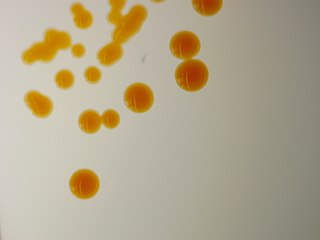Related Research Articles
Sphingomonas paucimobilis is a strictly aerobic Gram-negative bacterium that has a single polar flagellum with slow motility. The cell size is around 0.7 x 1.4 μm. It is usually found in soil. As with the other members of the genus, its biochemistry is remarkable in possession of ubiquinone 10 as its major respiratory quinone, and of glycosphingolipids instead of lipopolysaccharides in its cell envelope. It has been implicated in various types of clinical infections.
Sphingomonas yanoikuyae is a short rod-shaped, strictly aerobic, Gram-negative, non-motile, non-spore-forming, chemoheterotrophic species of bacteria that is yellow or off-white in color. Its type strain is JCM 7371. It is notable for degrading a variety of aromatic compounds including biphenyl, naphthalene, phenanthrene, toluene, m-, and p-xylene. S. yanoikuyae was discovered by Brian Goodman on the southern coast of Papua New Guinea. However, Sphingomonas have a wide distribution across freshwater, seawater, and terrestrial habitats. This is due to the bacteria's ability to grow and survive under low-nutrient conditions as it can utilize a broad range of organic compounds.
Sphingomonas adhaesiva is a species of bacteria. Its type strain is JCM 7370. The cells are rods and it has one polar flagellum. It is aerobic.
Sphingobium japonicum is a hexachlorocyclohexane-degrading bacteria with type strain MTCC 6362T. Its genome has been sequenced.
Sphingobium indicum is a hexachlorocyclohexane-degrading bacteria with type strain MTCC 6364T. Its genome has been sequenced.
Sphingobium francense is a hexachlorocyclohexane-degrading bacteria with type strain MTCC 6363T.
Sphingomonas asaccharolytica is a bacterium from the genus of Sphingomonas which has been isolated from roots from an apple tree in Japan.
Sphingomonas daechungensis is a Gram-negative, non-spore-forming, aerobic and non-motile bacteria from the genus of Sphingomonas which has been isolated from sediments of the Daechung water reservoir in Korea.
Sphingomonas faeni is a Gram-negative bacteria from the genus of Sphingomonas which has been isolated from indoor dusts from animal sheds in Finland.
Sphingomonas fennica is a bacterium from the genus of Sphingomonas which has been isolated from groundwater, which was collected near a sawmill in Finland.
Sphingomonas koreensis is a Gram-negative and aerobic bacteria from the genus of Sphingomonas which has been isolated from natural mineral water in Taejon in Korea. In one patient, with a meningeal drain, Sphingomonas koreensis was reported to cause meningitis.
Sphingomonas melonis is a bacterium from the genus of Sphingomonas which has been isolated from the plant Cucumis melo var. inodorus in Madrid in Spain. Sphingomonas melonis can cause brown spots on melon fruits from the melon plant. In rice plants it can have disease-preventing effects, the seed-endophytic strain Sphingomonas melonis ZJ26 that can be naturally enriched in certain rice cultivars, confers diseases resistance against a bacterial pathogen and is vertically transmitted among plant generations via their seeds.
Sphingomonas oligoaromativorans is a Gram-negative, strictly aerobic, oligotrophic and non-motile bacteria from the genus of Sphingomonas which has been isolated from humus forest soil in the Gyeryong Mountain National Park in Korea.
Sphingomonas oligophenolica is a Gram-negative, strictly aerobic and non-motile bacteria from the genus of Sphingomonas which has been isolated from paddy field soil in Japan. Sphingomonas oligophenolica has the ability to degrade phenolic acids.
Sphingomonas pruni is a bacterium from the genus of Sphingomonas which has been isolated from the roots of the tree Prunus persica in Japan .
Sphingomonas roseiflava is a bacterium from the genus of Sphingomonas which has been isolated from the plant Setaria viridis in the Ibaraki Prefecture in Japan.
Sphingomonas soli is a Gram-negative, non-spore-forming and rod-shaped bacteria from the genus of Sphingomonas which has been isolated from soil from a ginseng field in Korea. Sphingomonas soli produces beta-glucosidase.
Sphingomonas xinjiangensis is a Gram-negative, aerobic and motile bacteria from the genus of Sphingomonas, which has been isolated from the desert sand of Xinjiang in China.

Sphingomonas aliaeris is a rod-shaped, strictly aerobic, Gram-negative, non-spore-forming, red-orange-pigmented species of bacteria, which has been isolated primarily from pork steak packed under CO2-enriched modified atmosphere. Its name derives from Latin alius (for “other”) and aer (for “air” or “atmosphere”). It was identified to be a potential food spoilage organism, which is non-pathogenic to humans.

The species Rhizorhabdus wittichii, formerly Sphingomonas wittichii, is a Gram-negative, rod-shaped motile bacterium, with an optimum growth temperature at 30 °C. It forms a greyish white colony. It has been found to have a 67mol% of DNA G+C content.
References
- ↑ Yabuuchi E, Yano I, Oyaizu H, Hashimoto Y, Ezaki T, Yamamoto H (1990). "Proposals of Sphingomonas paucimobilis gen. nov. and comb. nov., Sphingomonas parapaucimobilis sp. nov., Sphingomonas yanoikuyae sp. nov., Sphingomonas adhaesiva sp. nov., Sphingomonas capsulata comb. nov., and two genospecies of the genus Sphingomonas". Microbiology and Immunology . 34 (2): 99–119. doi: 10.1111/j.1348-0421.1990.tb00996.x . PMID 2111872. S2CID 23019663.